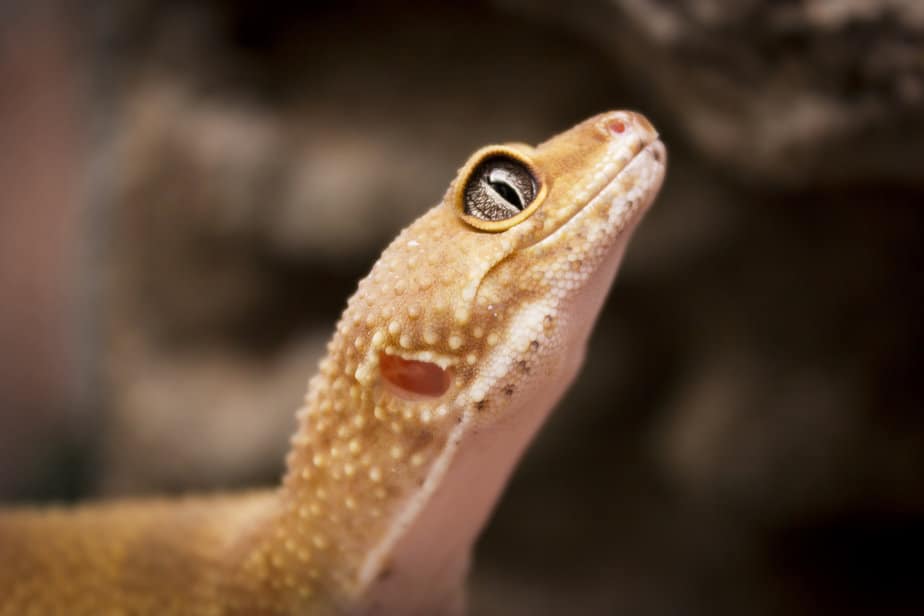Are you a proud leopard gecko owner? Do you want to ensure your little buddy is healthy and happy? Look no further!
In this article, we will identify the primary signs to look for in a healthy leopard gecko. Plus, we will show you how to increase your leopard geckos overall well-being and happiness levels.

can’t wait to share with you all the tips and tricks to keep your gecko thriving! So, let’s get started!
Identifying Physical Signs of Health
Body Condition
A healthy leopard gecko should have a well-rounded body with no visible bones sticking out.
Their tail should be plump and thick, it serves as a fat storage for the gecko.
Rapid weight loss or a thin tail can indicate an issue, so be sure to regularly monitor your gecko’s weight.
Shedding
Leopard geckos shed their skin regularly; observing their shedding process is crucial.
A healthy leopard gecko will have a complete shed without any leftover skin on their body.
Stuck shed can be gently removed by giving your gecko a bath to stimulate the shedding process.
Eyes and Nostrils
Clear, bright, and alert eyes are signs of a healthy leopard gecko. Their eyes should be wide open and vibrant.
Sunken eyes could indicate dehydration, while eyes that cannot open may require veterinary treatment for an infection.
Additionally, their nostrils should be free of discharge, which can signify respiratory infection.
If you notice any irregularities in your gecko’s eyes or nostrils, it’s essential to consult a veterinarian for proper evaluation and treatment.
Behavioral Indicators of Happiness
Activity Levels
A happy and healthy leopard gecko is an active one. They should explore their tank, move between warm and cool spots, and approach the glass when hungry or when they notice their owner (Pet Keen).
Brightness and alertness in their appearance are also signs of happiness.
Appetite and Eating Habits
A good appetite is another sign of a happy leopard gecko. A healthy gecko will be interested in food and eat regularly.
Pay attention to their eating habits to ensure they are nourished and content.
Sleep Patterns
Leopard geckos are crepuscular creatures, which means they are most active during dawn and dusk.
Observe their sleep patterns and activity during these periods. Consistency in sleep and wakefulness can indicate a healthy and happy gecko.
Checking for Symptoms of Illness
When evaluating your leopard gecko’s health, it’s essential to check for symptoms of illness.
Look for any unusual signs indicating your pet is not feeling well.
This section will discuss common symptoms to watch out for, including swollen limbs or joints, stress marks, and discolored droppings.
Swollen Limbs or Joints
Swollen limbs or joints can be a sign of infection, injury, or metabolic bone disease.
Examine your gecko’s legs and joints carefully to check for any unusual swelling or redness.
If you notice any abnormalities, seek veterinary advice immediately.
Stress Marks
Leopard geckos may develop stress marks when they are anxious or unhealthy.
These are usually seen as darkened lines or spots on the skin, typically on the belly area.
If your gecko has stress marks, assess its environment, and make necessary adjustments to create a more comfortable and stress-free habitat.
Remember to closely watch your gecko’s behavior and appearance to ensure the stress marks don’t worsen.
Discolored Droppings
Healthy leopard gecko droppings should be dark brown or black with a white urate section.
Discolored or unusual droppings may indicate an issue with digestion, parasites, or bacterial infections.
If your gecko’s droppings appear discolored, monitor the situation closely, and consider consulting a veterinarian if the problem persists.
Providing the Right Environment
Ensuring that your leopard gecko is healthy and happy requires creating the proper environment in their terrarium.
This section will cover important aspects like housing and substrate, temperature and humidity, and providing space for natural behaviors.
Housing and Substrate
Leopard geckos need a comfortable and spacious enclosure to thrive.
A 20-gallon tank is ideal for an adult gecko, while a juvenile will do well in a 10-gallon tank.
For their substrate, avoid using sand as it can cause impaction issues.
Instead, opt for safe options like reptile carpets, paper towels, or tile flooring. Always ensure the enclosure is secure and well-ventilated. Sphagnum moss also makes a great substrate.
Temperature and Humidity
Temperature plays a crucial role in the health and well-being of your gecko.
You should create an internal environment with a gradient in temperature. The warm side of the tank should be around 88-92°F (31-33°C) and the cool side between 70-75°F (21-24°C).
Humidity should be kept between 20-40%, and a humid hide should be available for shedding assistance.
Provide Space for Natural Behaviors
Leopard geckos are curious and active creatures. Providing a terrarium that allows them to exhibit their natural behaviors is important to keep them happy.
This includes providing appropriate hiding spots, climbing opportunities, and areas for basking.
Enrichment items such as rocks, branches, and plants can enhance their environment and stimulate their senses.
Conclusion
You should now understand the various factors contributing to a happy and healthy leopard gecko.
Paying attention to their behavior, appetite, and overall appearance is essential to ensure their well-being.
Make sure to provide proper care, a suitable environment, and a diet that meets their nutritional needs.
Leopard geckos are relatively low-maintenance pets, but responsible pet ownership is still necessary.
Keep an eye on the following signs to ensure their happiness and health:
- Regular eating habits and good appetite
- Consistent digestion and elimination
- Exploring and moving within their habitat
Regular check-ups with a veterinarian experienced in reptile care are also vital to maintaining your leopard gecko’s well-being.
Taking these precautions and providing your leopard gecko with a loving and secure home can greatly enhance their happiness and health.
